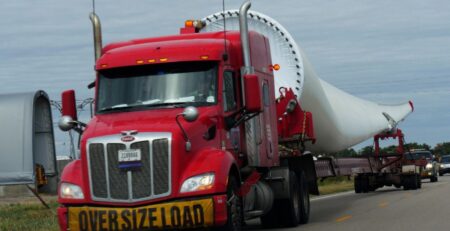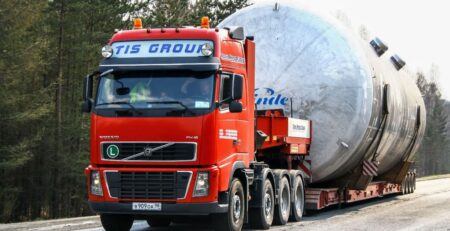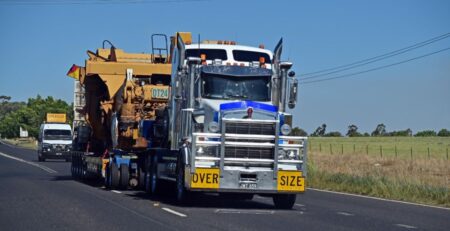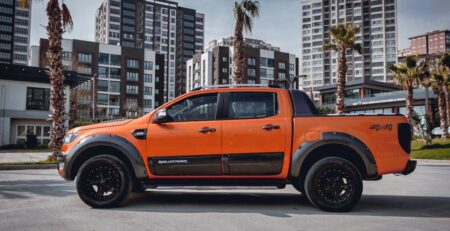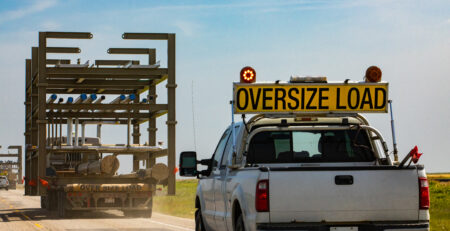Imagine driving on the highway and encountering a massive object ahead — it’s an oversized load, large enough to dwarf regular vehicles. Ensuring safe passage for such colossal cargo is the pilot car, or escort vehicle, an indispensable part of the transportation of oversized loads. These specialized vehicles play a critical role in navigating through traffic, warning other road users, and upholding safety on the roads.
Pilot cars are the unsung heroes that facilitate seamless integration between everyday traffic and oversized transports. They not only herald the approach of large loads but also ensure compliance with traffic regulations, prevent potential accidents, and coordinate with truck drivers to deliver goods safely and efficiently. The expertise of pilot car operators is crucial in mitigating risks associated with transporting oversized cargo.
In this article, you will learn about:
- The important role of pilot cars in heavy haul transport
- State-specific regulations that govern their operation
- Essential vehicle requirements for optimal functionality
- Strategies to enhance road safety through effective pilot car operations
- Benefits derived from employing pilot cars during transportation
Discover how these escort vehicles contribute to the orderly flow of traffic and protect both infrastructure and lives when heavy loads hit the road.
Understanding Pilot Cars and Their Role
A pilot car, also commonly referred to as an escort vehicle, is a vital component in the transportation of oversized loads. These are essentially vehicles that accompany heavy, wide or tall loads during transport. The primary role of a pilot car is to warn other motorists on the road about the approaching oversized load, thus ensuring safety for everyone using the road.
Pilot cars are indispensable when it comes to moving oversized loads. This is because such loads can pose significant hazards on the road due to their larger-than-normal size, making them challenging to navigate through traffic without causing disruptions or accidents.
The reason behind this is simple: oversized loads extend beyond the standard vehicle width, length or height, potentially obstructing other drivers’ vision or causing traffic congestion.
Responsibilities of Pilot Cars
Pilot cars perform several key responsibilities during transport operations:
- Alerting Other Motorists: Pilot cars are equipped with signs and lights that notify other drivers of an incoming oversized load. This allows motorists to anticipate and prepare for potential changes in traffic flow or lane usage.
- Route Planning: Pilot car operators are tasked with planning the safest and most efficient route for transporting the oversized load. They use maps and GPS systems to evaluate different routes and select the best one based on factors such as road conditions, traffic patterns, and local regulations.
- Communication: A vital task for pilot car operators is maintaining constant communication with the truck driver transporting the oversized load. This is achieved through CB radios, allowing them to relay important information about road conditions, traffic changes, and any potential obstacles ahead.
- Ensuring Compliance: Pilot cars play a critical role in ensuring that transportation operations adhere to state-specific rules and regulations related to oversized loads. This includes checking permits, verifying route plans, and confirming that all necessary safety measures are in place.
Importance of Understanding Pilot Cars
In essence, pilot cars serve as the eyes and ears of a transportation operation, keeping everyone on the road safe while facilitating the efficient transport of oversized loads. Understanding their role is crucial for anyone involved in the transportation industry, whether you’re a truck driver, a logistic manager, or an aspiring pilot car operator.
The Different Types of Pilot Cars
Pilot cars are crucial for safely transporting oversized loads. They have different roles depending on their position relative to the heavy haul truck. Here are the main types:
1. Lead Car
The lead car travels in front of the oversized load, scouting for potential hazards on the route such as low-hanging branches, narrow bridges, or construction zones. This proactive approach allows for timely adjustments to the route if needed.
Key Functions:
- Scouting and reporting road conditions
- Communicating with the truck driver about upcoming traffic changes
- Coordinating with authorities when necessary
2. Chase Car
Positioned behind the load, the chase car serves as a protective barrier between the heavy haul and other vehicles. By monitoring the load’s movement and alerting trailing traffic to its presence, this type of pilot car enhances rear safety.
Key Functions:
- Alerting following traffic to keep a safe distance
- Observing and reporting any issues with the load or trailer to the truck driver
- Assisting with lane changes and merges from behind
3. Pole Car
A specialized variant is the pole car, equipped with a high pole used to gauge clearance for height-restricted areas. Precise measurement is crucial to prevent bridge strikes or damage to infrastructure.
Key Functions:
- Measuring bridge clearances and overhead obstructions
- Ensuring height compliance throughout the journey
- Preventing costly damages by verifying vertical clearances ahead of time
4. Flag Car
In some cases, additional flag cars might be employed for extra-wide loads requiring multiple lanes. These pilot cars are marked with flags and “Oversized Load” signs to maximize visibility and warn adjacent traffic.
Key Functions:
- Enhancing visibility of the transport operation
- Facilitating smooth passage through multi-lane roads
- Coordinating with lead and chase cars for comprehensive safety
Each type of pilot car plays an integral part in ensuring that oversized loads reach their destination without incident. By understanding these roles, you can appreciate how they collectively contribute to a seamless transportation process where safety is paramount.
Ensuring Compliance: State Regulations, Certification, and Training for Pilot Cars
Driving a pilot car isn’t as simple as hopping into the vehicle and hitting the road. State regulations, certification, and training are pivotal aspects that every pilot car operator must adhere to.
State Regulations
Regulations vary from one state to another, with each jurisdiction setting its own rules to maintain consistency and uphold safety standards during transport operations. These regulations act as guidelines for operators, helping them understand their responsibilities better while ensuring the safe transportation of oversized loads.
Certification Process
When it comes to certification, aspiring pilot car drivers should be prepared for a comprehensive process designed to gauge their skills and readiness for the job. The specifics of the certification process can differ by state but generally include elements such as:
- Completing an approved training course
- Passing a written examination
- Having a clean driving record
- Obtaining appropriate insurance coverage
Importance of Training
Training plays an equally significant role in preparing drivers for their duties as a pilot car operator. It equips them with essential knowledge like understanding different types of oversized loads, and learning about critical safety measures, effective communication techniques with truck drivers, and comprehending the importance of route planning.
So how do you stay on top of ever-changing state-specific regulations? One way is by regularly visiting your state’s Department of Transportation or similar agency’s website. This can serve as a valuable resource for learning about current rules and updates related to pilot car operations in your jurisdiction.
In the end, adhering to state regulations, obtaining proper certification, and undergoing necessary training are not just legal requirements but also crucial steps towards becoming a skilled and reliable pilot car operator.
Meeting Vehicle and Equipment Requirements
When it comes to serving as a pilot car, not just any vehicle will do. The vehicle requirements for pilot cars are dictated by factors such as visibility and communication capabilities. High visibility is a must – the vehicle should be easily distinguishable from regular traffic. A sedan or a light truck is generally preferred due to its maneuverability.
The color of the vehicle also matters. Bright colors like orange, yellow, or white are typically chosen as they stand out on the road. A critical element is the rotating or flashing amber light mounted on top of the vehicle. This increases visibility and notifies other motorists of the approaching oversized load.
Communication capabilities are another crucial aspect of suitable pilot cars. The car should be equipped with a Citizens Band (CB) radio or two-way radio to maintain constant communication with the truck driver transporting the oversized load.
Equipment Requirements
Now, let’s talk about equipment requirements, which are just as important. A pilot car should be equipped with:
- Signs: Oversized Load or Long Load signs that are visible from both front and rear.
- Flags: Red or orange safety flags attached to all corners of the sign.
- Lights: Flashing amber lights on top of the vehicle.
- Height Pole: Used to gauge clearance when transporting high loads.
- Emergency Equipment: Including fire extinguisher, first aid kit, flares, cones, and more.
Remember that this is not an exhaustive list. Different states might have additional requirements based on specific local conditions.
Lastly, regular maintenance of both the vehicle and its equipment cannot be overstressed. It ensures reliability during operations and minimizes potential downtime. Regular checks on tires, brakes, lights, and communication devices keep the pilot car in optimal condition.
Meeting these vehicle and equipment requirements is essential for every pilot car operator. It guarantees effectiveness in their role and contributes significantly to road safety during the transportation of oversized loads.
Promoting Road Safety Through Effective Communication and Traffic Management
Pilot cars play a crucial role in promoting road safety and effective traffic management. They do more than just accompany oversized loads—they prioritize everyone’s safety on the road.
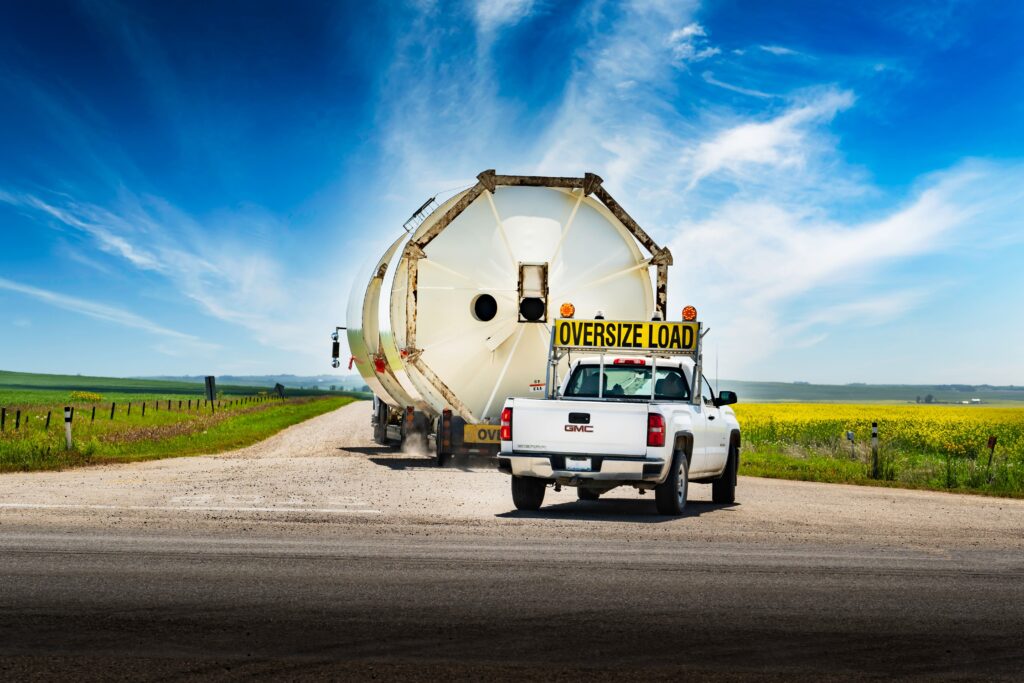
The Role of a Pilot Car
A pilot car acts as the truck driver’s extra set of eyes and ears. It has two main responsibilities:
- Managing Traffic Flow: By staying ahead of the truck, the pilot car ensures that other vehicles are aware of its presence. It helps create a safe buffer zone and maintains a steady speed to prevent sudden braking or lane changes.
- Providing Advance Warning: The pilot car alerts the truck driver about any upcoming obstacles or road conditions that may require adjustments. This early notification allows other drivers to react accordingly, reducing the risk of accidents.
The Importance of Communication
Smooth communication between the pilot car operator and the truck driver is crucial for safe transportation. They rely on CB radios as their primary means of contact, enabling real-time updates and coordination.
Here’s why effective communication matters:
- Coordinating Moves: The pilot car operator guides the truck driver through complex maneuvers such as lane changes, turns, or navigating tight spaces. Clear instructions help both parties work together seamlessly.
- Avoiding Hazards: By sharing information about traffic conditions, potential dangers, and route changes, the pilot car operator assists the truck driver in making informed decisions. This proactive approach minimizes risks along the journey.
“Communication is key in any partnership, especially on the road. The ability to convey information accurately ensures a safer journey for everyone involved.” – John Davis, Experienced Pilot Car Operator
How Pilot Cars Enhance Road Safety
The combined efforts of efficient traffic management and effective communication contribute significantly to road safety:
- Preventing Accidents: By managing traffic flow and providing timely warnings, pilot cars reduce the chances of collisions involving oversized loads. This proactive approach allows other motorists to adjust their driving behavior accordingly.
- Protecting Infrastructure: Pilot cars help safeguard bridges, tunnels, power lines, and other structures by ensuring that the height and weight of the load are compatible with the route. This preventive measure prevents costly damages and disruptions.
- Ensuring Compliance: Pilot cars play a vital role in enforcing regulations related to oversized loads. They help monitor adherence to permit conditions and ensure that the convoy follows approved routes, minimizing potential legal issues.
In summary, pilot cars serve as dedicated safety partners for truck drivers, enhancing road safety through their proactive presence and effective communication.
The Vital Role of Pilot Cars in Preventing Damage and Accidents
When it comes to the benefits of pilot cars, it’s hard to overstate their importance. These vehicles play a pivotal part in transportation operations, particularly when it comes to oversized loads. Their key role is to mitigate potential hazards that could lead to damage or accidents.
1. Reducing the Risk of Bridge Strikes
One scenario where the advantage of pilot cars becomes evident is in reducing the risk of bridge strikes. As pilot cars are often equipped with height poles, they can measure the clearance of upcoming bridges and overhead obstacles. This allows the truck driver to be alerted in advance if the load is too high, preventing costly and potentially dangerous bridge strikes.
2. Ensuring Timely Delivery of Goods
Another critical benefit lies in their ability to ensure timely delivery of goods. By providing accurate route planning and traffic management, pilot cars help avoid delays caused by roadblocks, traffic congestion, or other unforeseen circumstances.
3. Preserving Road Infrastructure
Pilot cars also contribute significantly to preserving road infrastructure. Oversized loads can cause considerable wear and tear on roads and bridges. With pilot cars guiding the way, these heavy loads can be navigated safely around vulnerable road sections or directed towards routes designed to bear such weight.
4. Acting as an Extra Layer of Protection for Other Road Users
Additionally, they act as an extra layer of protection for other road users. Equipped with warning signs, flashing lights, and often brightly colored for visibility, they alert oncoming traffic about the oversized load. This early warning system helps prevent accidents involving unsuspecting motorists who might not realize the extent of the approaching vehicle’s dimensions.
5. Safeguarding the Cargo Itself
Lastly, pilot cars safeguard the cargo itself. By preemptively identifying potential risks on the route such as low-hanging wires or narrow lanes, they help ensure that the oversized load reaches its destination undamaged.
In essence, pilot cars bring an array of benefits to transportation operations. Their integral role in preventing damage and accidents underscores their value in ensuring safe and efficient transport of oversized loads.
Pilot cars, also known as escort vehicles, are essential for transporting oversized loads safely. They play a crucial role in ensuring the smooth and incident-free delivery of these large cargoes. If you’re interested in becoming a pilot car operator and making a significant impact in this industry, here’s what you need to know about getting certified in your state:
1. Understand the Responsibilities
Being a pilot car operator comes with important duties that directly contribute to road safety. Here are some key responsibilities:
- Mastering traffic management techniques to safely guide heavy load drivers through challenging routes.
- Communicating effectively with truck drivers to coordinate movements and address any potential issues on the road.
- Paying close attention to safety protocols and taking proactive measures to prevent accidents.
2. Be Aware of State Regulations
It’s crucial to familiarize yourself with the specific requirements set by your state regarding pilot car operations. This knowledge is essential for ensuring compliance and legal operation. Some common areas covered by state regulations include:
- Licensing and certification processes for pilot car operators.
- Vehicle specifications and restrictions based on size, weight, and load type.
- Necessary permits or authorizations for transporting oversized loads within the state.
3. Meet Vehicle and Equipment Standards
To perform their duties effectively, pilot cars must meet certain standards in terms of visibility and equipment. Here are some key aspects to consider:
- Pilot cars should be easily noticeable on the road, typically achieved through the use of high-visibility colors or markings.
- Essential equipment such as signs, flags, lights (including flashing or rotating lights), and two-way radios (such as CB radios) should be installed and in proper working condition.
- Depending on the state or specific job requirements, additional tools like height poles or width measuring devices may be necessary.
4. Prioritize Safety and Communication
Safety is paramount in pilot car operations. Here’s how it can be ensured through effective traffic management and communication:
- Maintaining a safe distance from the escorted load and other vehicles on the road.
- Anticipating and reacting to potential hazards or obstacles ahead.
- Using clear hand signals or radio communication to relay instructions between the pilot car operator and truck driver.
- Staying updated on weather conditions or any road incidents that may affect the journey.
5. Understand the Benefits
Aside from their regulatory role, pilot cars offer several advantages to both the transportation industry and the general public:
- Preventing damage to infrastructure such as bridges, overhead structures, or roadside objects by ensuring safe clearance for oversized loads.
- Minimizing the risk of accidents caused by limited visibility or maneuverability of heavy loads.
- Helping trucking companies avoid higher insurance premiums associated with frequent claims due to accidents or property damage.
- Contributing to smoother delivery schedules by efficiently navigating through congested areas or construction zones.
By recognizing these benefits and supporting the use of pilot cars, we can collectively prioritize safety and efficiency in our transportation infrastructure.

